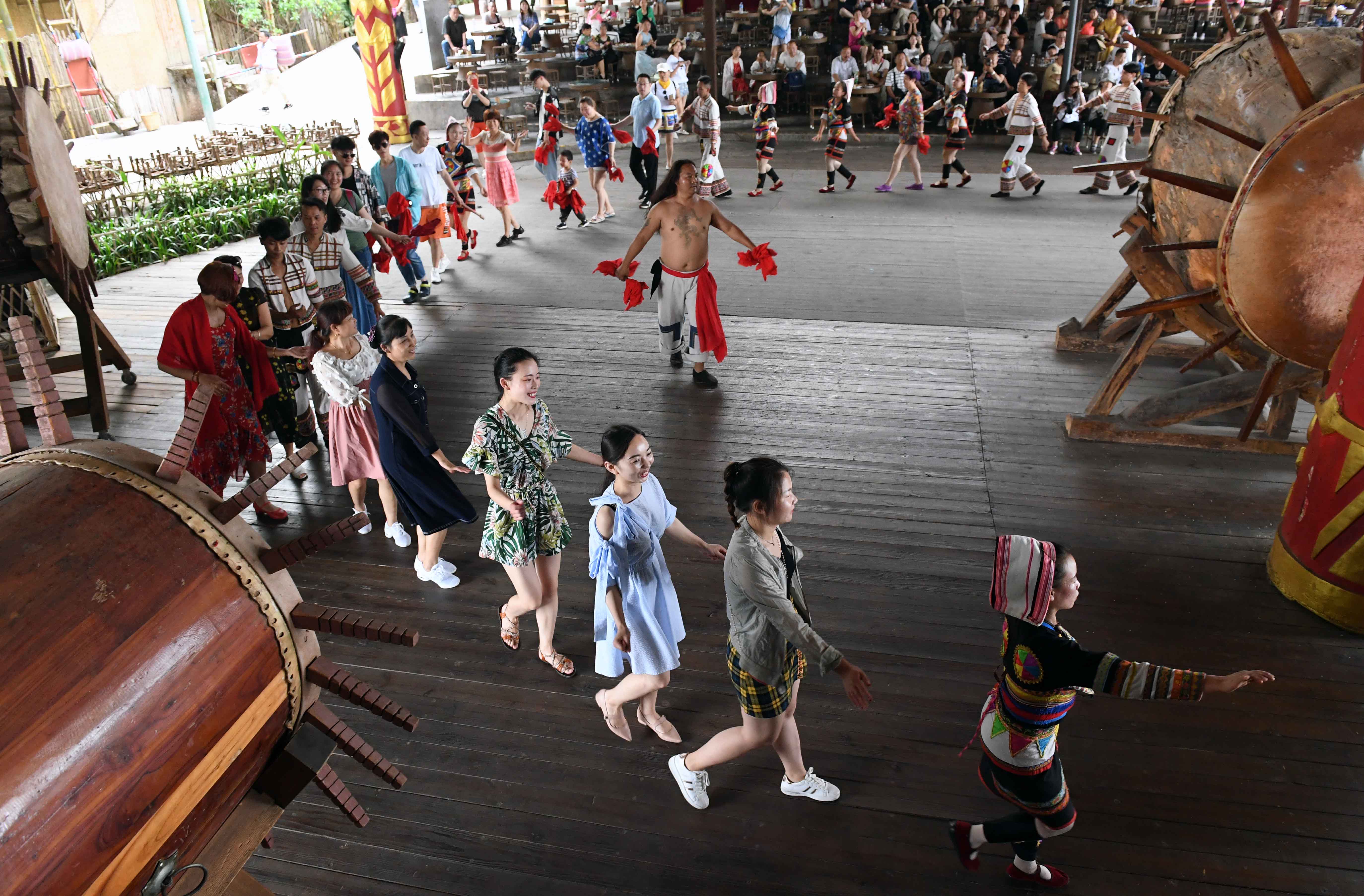
Photo taken on June 4, 2019 shows visitors and performers dancing together to the drum beat in Jino Village, southwest China's Yunnan Province. (Xinhua/Yang Zongyou)
XISHUANGBANNA, June 12 (Xinhua) -- In front of a giant wooden drum, Che Jie sprays wine and rice amid a group of mysterious dancers donning red, white and black clothes. He whispers some bizarre words and performs a special ritual as eerie, dramatic music featuring drums and gongs blasts out from behind a pillar covered by smiling oxheads.
It's a performance by the Jino ethnic people in the Jino Village Tourist Attraction in the lush green mountainous township of Jino Mountain in southwest China's Yunnan Province. The township oversees 46 villages, including Jino Village.
Che, 63, has played the big drum his entire life. The difference is, in the past, he performed the drum ritual to pay tribute to ancestors or when someone died in the village. These days, he plays during performances for tourists.
"When I play the drum, I whisper all the best wishes to the tourists," said Che, a revered ethnic head in Jino Village. "I wish everyone a good year ahead, a safe journey home and longevity."
Local authorities are betting on the distinctive traditions of the Jino people to help power tourism, particularly the drum culture.
Last year, the tourist attraction drew 168,900 visitors. In the first five months of this year, the number of tourists has already exceeded 100,000, according to official figures.
The Jino people were a primitive tribe before 1949 when the People's Republic of China was founded. Jino means "the offspring of the uncle" in the local language, as folklore has it that the group's ancestors were a brother and a sister. Before 1949, the Jino people were basically living "slash and burn" lifestyles, and drum playing was the most important part of their cultural life.
According to local legends, the Jino people's creator, a goddess, made a boy and a girl and put them inside a big drum. The two floated on water for seven days, until they settled. They got married and gave birth to human beings.
"The Jino drum is the most mysterious and iconic thing among locals because it is believed to be connected to the goddess of the Jino people," Che said. "No one dares to make jokes in front of the drums, or say anything offensive."
The drums, usually made of wood and cowhide, must be suspended in the air instead of on the floor, as a way of showing respect to the goddess, Che said.
The Jino people were an "isolated" group in the past. They shunned strangers from outside their villages. People from different villages were not allowed to marry each other.
When teenage boys and girls come of age, Che also performs a ritual ceremony marking their growth, by spraying rice and wine. He leads the teenagers in singing local epics, which depict the hardships in labor and life, while also imparting moral lessons to them. After the ceremony, the teenagers' parents give them work tools and ethnic clothes worn by adults. Girls should wear a bun to show they have grown up.
In the township, images of the drums can be seen on almost every wall of the local buildings.
In 2008, the Jino drum dance was listed as a national-level intangible cultural heritage, significantly lifting its profile around the country.
In recent years, as the rural vitalization strategy gains steam, rural tourism is booming in China's countryside. The beautiful scenery and local delicacies, coupled with the mysterious drum culture, are luring a huge number of stressed-out urbanites. Improved infrastructure, like newly built roads, contributed to the tourism boom.
In the Jino Village Tourist Attraction area, the drum ritual is performed almost every day, with at least 30 dancers performing in synch. All of them are Jino people.
Che came to perform for the tourist attraction in 2016. He currently rakes in about 3,000 yuan (434 U.S. dollars) a month from the performances.
"I can make two yuan for each performance, in addition to my basic salary," he said.
When he is not performing, Che goes back home to grow tea and feeds pigs.
As more visitors come, many of the Jino people have jumped on the bandwagon of rural tourism, and have begun to provide unique Jino specialties to visitors in the Jino Village tourist attraction, where all villagers are eligible to do business.
Zi Mei, 45, has just opened a Jino guesthouse, providing accommodation, as well as Jino food to visitors.
"More than 300 people have visited my guesthouse in the past two months," she said. "The tourism business is pretty good here these days."
Che hopes that while the drum culture boosts local tourism business, the Jino drum dance will be appreciated more in society.
"The Jino drum dance faces a lack of inheritors, and I hope more people will join us in passing on the traditional culture," he said. Enditem



